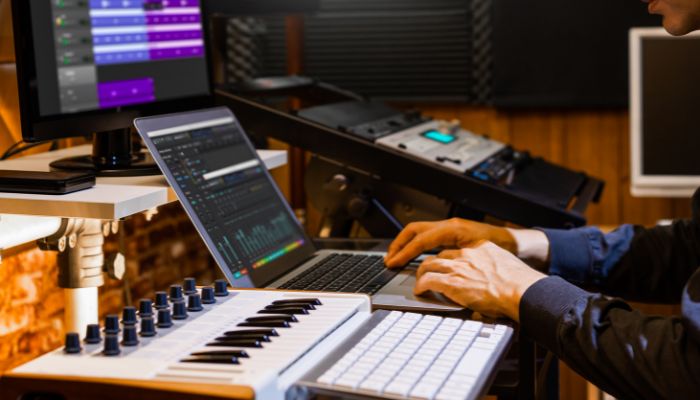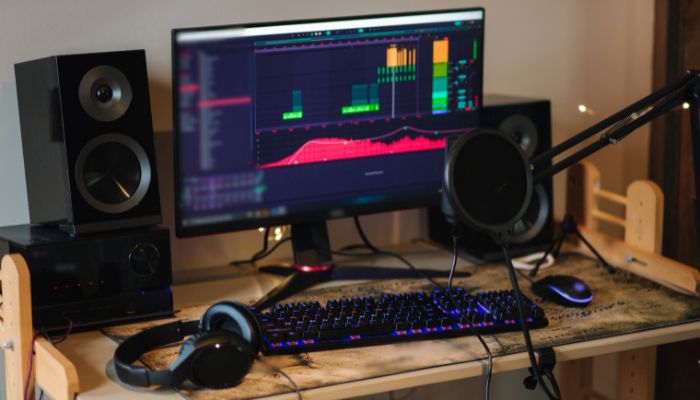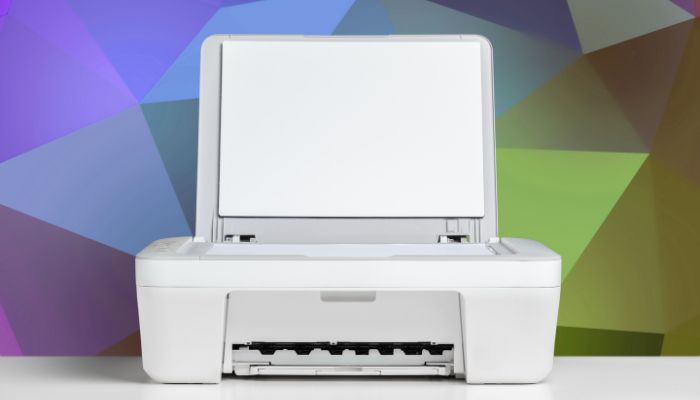Hardware vs software in audio production – it’s an interesting question that students often think about.
It’s far too tempting to bang on about the benefits of DAWs for all things music production when there are many alternatives out there.
Hardware was the mainstay of music production until the digital era took a grip through the 70s and 80s. Two-track recording only became widespread in the 1940s and more advanced analog recording studios didn’t pop up until the late 50s and 60s.
Prior to the era of digital music, most music was recorded to tape and cut to vinyl for playback on analogue speaker systems. There simply was no such thing as music production software until some 40 years ago – and that’s not long ago at all!
Now, most of us take digital music production for granted. Using DAWs and plugins, it’s possible to emulate everything from Abbey Road consoles using Waves plugins to professional analogue compressors, reverbs, delays and much more.
But should students look no further than the DAW, or are there other alternatives out there that are better for music production?
Software Production: The Gold Standard?
Let’s first try and define what software music production is.
It’s now possible to create music with no hardware except the laptop or PC itself. DAWs – digital audio workstations – take on the role of the traditional recording studio. Tracks can be added, removed, edited and controlled as they could on a real mixing desk. There are sends and busses, like on a real mixing desk.
You don’t even strictly need an audio interface or anything other than a basic DAW with some stock plugins and basic headphones.
In addition to all of these basic functions, DAWs enable producers to craft and shape our sounds in ways never before possible with analogue gear.
Time-stretch algorithms conform sounds to different tempos, we can match the pitch and key of different instruments and of course, access a vast array of software effects and instruments.
Many software instruments are now meticulously modelled on the real thing. It begs the question, why bother with hardware anymore?
- Moog (or virtually any other classic) synthesisers? There’s a plugin for that.
- High-end mastering compressors like the Shadow Hill Mastering Compressor? There’s a plugin for that.
- Famous Abbey Road tape distortion? There’s a plugin for that.
The list of software instruments, devices, effects and tools is pretty much endless. Any sound, any effect, any era – they’re all available in software format.
The main benefit? Cost. Building a fully-featured software studio is extremely cost-effective. Some analogue gear, like the Abbey Road REDD console, is priceless. You can buy the plugin for some £50…
It’s easy to see why producers are shunning hardware and options for software-centric music production setups.
The Strengths of Music Production Software
The strengths of a DAW-powered in-the-box setup that makes good use of plugins for instruments and effects are plain and obvious to see. These kinds of software setups are incredibly accessible, and powerful.
Even top engineers like Andrew Scheps (Jay-Z, Red Hot Chilli Peppers, Adele, Metallica) admit that they often forgo their multi-million pound/dollar recording studios for an ‘in-the-box’ software-led setup.
- Cheap and accessible.
- Feature-packed, flexible and powerful.
- Capable of doing most of the things a huge recording studio can do in terms of mixing, processing and mastering.
- Can use your own PC/laptop.
- Access to pretty much any effect, instrument or tool you can possibly imagine.
The Limitations of Music Production Software
Music production software does have its limitations. There are other options out there – we’ll cover them in a moment. But firstly, let’s expose some situations where music production software shows some signs of weakness.
The biggest cost associated with the modern DAW in-the-box music production setup is that you’ll need a bulletproof system to run everything on. It’s possible to spend between £500 and £1000 for a solid music production rig, but it won’t last forever and upgrading bits and pieces is pretty much inevitable at some stage.
Additionally, the DAW-based setup is not particularly convenient. Portable recording devices can be chucked in a bag – they’re rugged and durable, designed for the road. You might not want to take your PC/laptop everywhere you want to record.
- Updating your rig to meet the requirements of new software can be costly.
- If your PC/laptop fails, you face losing everything if you don’t have a solid backup.
- Things go wrong; corrupted sessions, broken plugins, instability, lag, etc.
- A desktop setup isn’t portable, which can be a massive disadvantage.
- Many argue that software instruments and effects still lack the authenticity and magic of the ‘real thing’.
The Alternatives: 4 Ways to Produce Music With Hardware
The DAW-led setup is inarguably flexible, powerful and cost-effective, but there are alternatives, both in terms of the production hardware itself and the instruments.
Let’s start with synthesisers and instruments.
The Best Hardware Synthesisers
Ok, this isn’t exactly a way to produce audio, but genuine hardware synths are doing a roaring trade even today – they’re very popular.
Software synths are brilliant, but when it comes to executing truly musical performances, they can still be a bit musically confining. It’s like comparing software guitars to the real thing, or acoustic drum kits to programmed electronic alternatives created in software like Superior Drummer. There’s a difference – music often just sounds better when performed on the real thing and not a software copy.
Synths are often quite expensive, but many offer real value to music producers looking to add instant authenticity to their music. They also double up as a live instrument for performances.
There are some classic and crazy modular synths out there and not all of them break the bank. For example, the Behringer 2600 Analog Synth is based on the 1970s ARP synth and offers some awesome flexibility for under £600.
Fans of the famous Roland 303, 606 and 808 synths often end up owning a hardware version, even though the sounds are readily available in software form.
The Virus TI is another firm fan-favourite that many types of electronic music producers seek to own.
Of course, you can’t forget Moog, Arturia, Korg and many other legendary brands that have been cranking out classic vintage throwbacks and up-to-date modern synths in recent years.
Some, like the Korg Volca range, Korg Monologue and Minilogue, Roland JU-06A and Modal Electronics CRAFTsynth sound awesome and are very affordable.
Strengths of Hardware Synthesisers and Instruments
- There’s no doubt that hardware synths are both fun and collectable, but they’re also inherently more musical than their software counterparts.
- Many argue that the tone of a real synth cannot be beaten in software form.
- Owning hardware synths gives you a tool for live performance as well as studio recording.
- Synths are just cool, many producers end up owning at least one, but many end up owning a lot!
Multi-Track Hardware Recorders
There is an alternative to DAW + interface recording setups: the multi-track recorder.
Tascam brought out the first Portastudio range in the 70s. These all-in-one devices allowed anyone to record music on the fly, without clunky sets of gear. Just plug some mics in, hit record and you’re good to go.
The modern versions of these all-in-one multi-track recorders have come on leaps and bounds and rate as sophisticated hardware recording tools. Tascam still leads the way with devices like the super-cheap DP004 and high-end 2488Neo. Boss also offers some superb compact multi-track recorders like the Boss BR600.
These devices combine the authentic control surface of a real studio with superb audio quality and powerful mixing controls. They’re superb for live sound applications, e.g. recording a live band or broadcast.
In these situations, controlling and monitoring the entire session from a laptop would be tricky. You need the assistance of physical controls like faders.
Many of these recorders allow you to export your tracks for processing in a DAW. This provides the best of both worlds; you can record and mix in the multi-track recorder and then do advanced mixing, processing and editing in your DAW.
Strengths of Multi-Track Hardware Recorders
- Multi-track recorders are an excellent way to obtain recordings of practically anything.
- They can be used in the studio or in a live audio situation. Many are cheap and easy to use, and they allow producers to record music in a natural and intuitive way that is free from their PC or laptop.
- Possible to export tracks to DAWs for further editing, but this doesn’t defeat the point of these portable, convenient and powerful audio production devices.
Groove Boxes, Beat Machines and Guitar Workstations
A fresh niche in the music production scene is the groove box. These types of devices allow you to produce and perform music at the same time. They’re designed for live musicians, buskers, performance artists or anyone who needs a streamlined solution for creating relatively simple tracks.
At the top-end, we have the Akai Professional MPC-X Standalone Production Machine. This superb device allows beatmakers to produce tight, effective compositions in practically any environment. Native Instruments Maschine is an example of a sort-of hybrid device that uses a stripped-down DAW.
Workstation keyboards like the Roland Fantom range, Yamaha Motif and Korg M3 follow a similar concept, but integrate keyboards into their all-in-one recording and performance devices.
There are options for guitarists too, like the Digitech GNX4. These allow guitarists and other instrumentalists to quickly create compositions on the fly, perfect for live performances and studio work.
Strengths of Groove Boxes, Beat Machines and Guitar Workstations
- These practical recording and production devices fuse the spontaneity of live performance with the flexibility of serious recording technology.
- Beat machines are perfect for hip hop, rap, trap and R&B producers, but can also augment DJ sets.
- Guitar or instrument workstations or jam boxes are perfect for buskers, live performers or those looking to create layered recorded sessions.
- These types of performances are hugely popular. There are tons of examples of these jams online, like FKJ and Masego above and Tash Sultana below.
Full Analog Vintage
If you want to go full analogue vintage then you definitely can. Tape recorders sell on secondhand sites all the time. Many favourites like the Yamaha MT8X and CMX 100 are very popular.
You can find analogue recording gear dating back to the 40s, 50s and 60s, and many of the more famous devices are highly sought after (and very expensive). Analogue gear that uses tubes and classic transistors creates a unique sound that plugin designers spend weeks trying to emulate in software form.
More musicians are turning to the real thing and are now incorporating genuine vintage gear into their productions.
Strengths of Vintage Recording Gear
- Plenty of choices on eBay and secondhand sites.
- Classic tone and authentic sound quality.
- Some cheap options out there.
- Good for those with electronics skills and experience; possible to repair old stuff.
Hardware Vs Software for Music Production: Is There a Winner?
Naturally, there is no objective winner. There are plenty of alternatives to the modern DAW + software instrument setup, though, and those willing to explore other options might just find something they really love.
It pays to look beyond the standard in-the-box setup, but that isn’t to discredit the in-the-box setup either, as the advantages are there for all to see.
From beat machines to guitar workstations, multi-track recorders and groove boxes, there is certainly more than one way to record music.
Of course, it’s also possible to opt for hybrid setups that incorporate some hardware recording methods/instruments and some software. Music and audio production is about the process as well as the result and finding fun and innovative ways to record is a creative process as well as a technical one.
The rules are there to be broken, after all!



